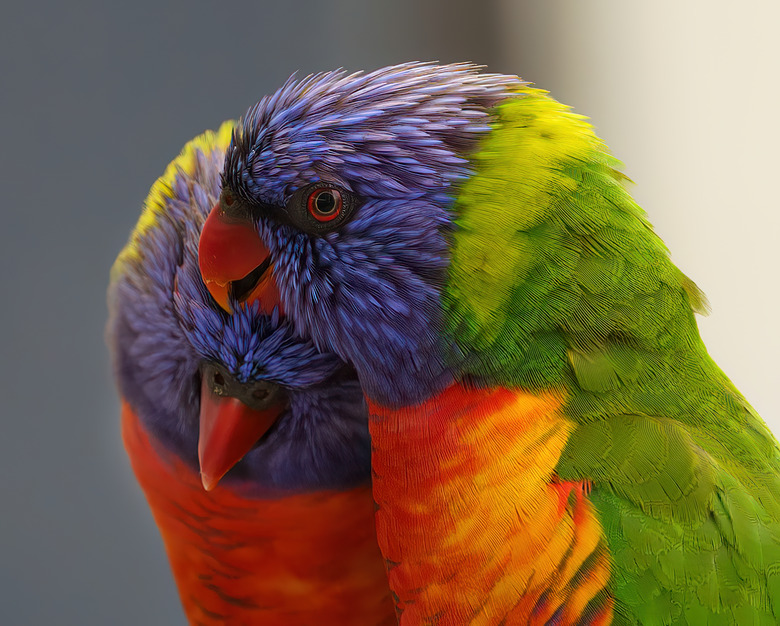How To Tell Male From Female Lorikeets
Lorikeets are small, colorful members of the parrot family who rarely grow larger than 12 inches from the tip of their head to the end of their tail. Common pet lorikeets, such as the rainbow lorikeet, offer few clues as to gender other than mating behavior. Both males and females look very much alike, even when they are fully grown, so if you need to know for certain, get your bird a DNA feather test.
Rainbow lorikeet female and male
Rainbow lorikeet female and male
The most popular pet lorikeet in the pet trade is the rainbow lorikeet. These brilliantly colored birds don't have any telltale signs as to gender, even as adults. Their vocalizations and appearance are identical as juveniles and as adults. If your birds are siblings and of the same age, it is possible that the male is slightly larger than the female, but this isn't always reliable.
Aggressiveness doesn't offer any clues. Both male and female lorikeets will bite, especially during the transition from juvenile to adult. It's important to be aware that this is normal and to understand what triggers biting in your bird. This could be anything from not wanting to go back in the cage to feeling threatened by your hand. Train your lorikeet not to bite by respecting his personal space and his territory and by letting him equate your hands with good things, like treats, playtime, and preening.
If you're seeing physical differences in your lorikeets, it's probably due to their age. Juvenile lorikeets have brownish or blackish bills and begin developing their adult plumage when they're about 60 days old. However, they will be a duller color than adults of breeding age.
Lorikeet mating behavior
Lorikeet mating behavior
Lorikeets are gregarious by nature, preferring to feed and nest in large flocks. As all birds look identical, comparing more than one bird's physical attributes will leave you clueless as to gender. However, lorikeet mating behavior offers a good clue to which bird is a rainbow lorikeet female and which is a male. At what age do lorikeets mate? Typically, they begin mating at age 12 to 15 months.
When the weather begins to warm, you'll probably start to witness breeding behavior in your lorikeets. A male will dip and twist his head as he looks at his intended with dilating eyes. He will hop around with a bowed head, flirting with the female and encouraging her to roll onto the ground. In the end, a receptive female might roll the male to the ground, and the lories will mate side by side or with one or the other on top.
If your bird suddenly starts bobbing his head at you and giving you the side-eye while his pupils dilate rapidly, it is likely a male. Birds bond with their owners, so if you have won a male's heart, you might be on the receiving end of a dance or even mating nips. Females lay eggs during breeding season whether or not there is a male present, so this is a reliable indicator that you have a female if she is the only bird.
Dimorphous lorikeet types
Dimorphous lorikeet types
Although rainbow lorikeets are the most common in the pet trade, a few other types of lorikeets offer a clue to whether they are male or female. In red-fronted lorikeets, for example, only the males of the species actually have red fronts. Even in lorikeet types where males and females are different, those differences can be very subtle. The red-throated lorikeet female has a duller red throat than the male, and her thighs are more purplish than the bright red on males.
Other types are more definitive. The red-flanked lorikeet male is the only one of this type of lorikeet that has the characteristic red flanks. He also has blue ear coverts and a blue rump. The female has a blue rump without red flanks, and her ear coverts are yellow.
References
- Beauty of Birds: Training / Behavioral Guidance of Pet Lories and Lorikeets
- Beauty of Birds: How to Stop Parrots from Biting: The Sharp Beak
- Oiseaux Birds: Rainbow Lorikeet
- Department of Primary Industries and Regional Development: Rainbow Lorikeet
- YouTube: Holistic University of Brisbane – Rainbow Lorikeet Courtship Dance and Mating
- Wonder Gardens: Learn About the Rainbow Lorikeet
- eBirds: Red-fronted Lorikeet
